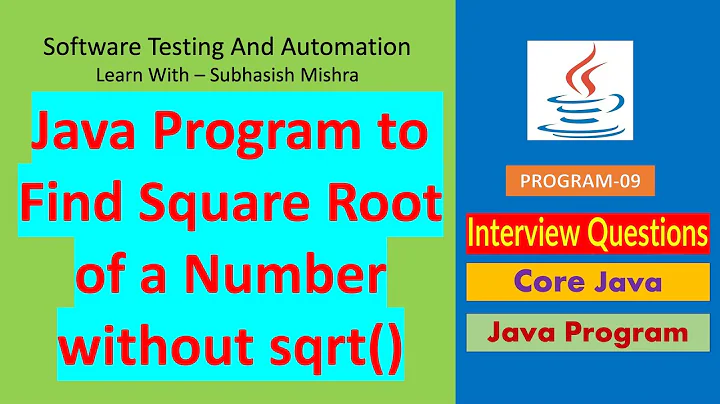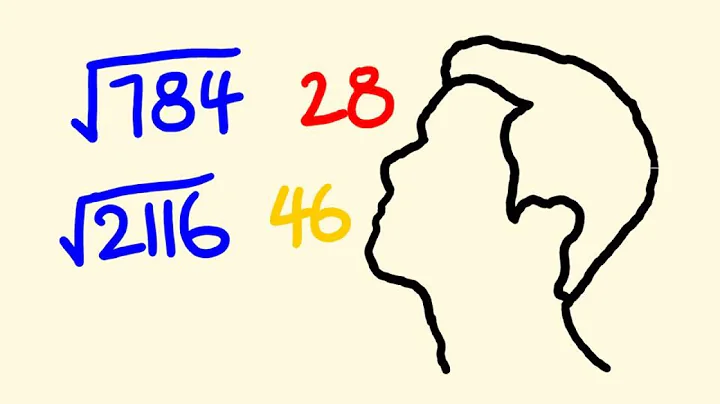(int) Math.sqrt(n) much slower than (int) Math.floor(Math.sqrt(n))
Solution 1
The Math.floor method just delegates the call to the StrictMath.floor method (as seen on java.lang.StrictMath's source code). This method is a native method. After this method the cast does not have to do anything because it is already a number that is equal to an integer (so no decimal places).
Maybe the native implementation of floor is faster than the cast of a double value to an int value.
Solution 2
I cannot reproduce the same results. Using this simple Java code below, the function without the call to Math.floor is consistently faster:
with floor elapsed milliseconds: 7354
without floor elapsed milliseconds: 4252
public class TestCast {
private static final int REPS = Integer.MAX_VALUE / 4;
private static void withFloor() {
long sum = 0;
long start = System.currentTimeMillis();
for (int i = REPS; i != 0; --i) {
sum += (int)Math.floor(Math.sqrt(i));
}
long end = System.currentTimeMillis();
long elapsed = end - start;
System.out.println("with floor elapsed milliseconds: " + elapsed);
System.out.println(sum);
}
private static void withoutFloor() {
long sum = 0;
long start = System.currentTimeMillis();
for (int i = REPS; i != 0; --i) {
sum += (int)Math.sqrt(i);
}
long end = System.currentTimeMillis();
long elapsed = end - start;
System.out.println("without floor elapsed milliseconds: " + elapsed);
System.out.println(sum);
}
public static void main(String[] args) {
withFloor();
withoutFloor();
}
}
Also, looking at the disassembled byte code we can clearly see the call to Math.floor in the first function and no call in the second. There must be something else going on in your code. Perhaps you can post your code or a shortened version of it that shows the results that you are seeing.
private static void withFloor();
Code:
0: lconst_0
1: lstore_0
2: invokestatic #2 // Method java/lang/System.currentTimeMillis:()J
5: lstore_2
6: ldc #3 // int 536870911
8: istore 4
10: iload 4
12: ifeq 35
15: lload_0
16: iload 4
18: i2d
19: invokestatic #4 // Method java/lang/Math.sqrt:(D)D
22: invokestatic #5 // Method java/lang/Math.floor:(D)D
25: d2i
26: i2l
27: ladd
28: lstore_0
29: iinc 4, -1
32: goto 10
35: invokestatic #2 // Method java/lang/System.currentTimeMillis:()J
38: lstore 4
40: lload 4
42: lload_2
43: lsub
44: lstore 6
46: getstatic #6 // Field java/lang/System.out:Ljava/io/PrintStream;
49: new #7 // class java/lang/StringBuilder
52: dup
53: invokespecial #8 // Method java/lang/StringBuilder."<init>":()V
56: ldc #9 // String with floor elapsed milliseconds:
58: invokevirtual #10 // Method java/lang/StringBuilder.append:(Ljava/lang/String;)Ljava/lang/StringBuilder;
61: lload 6
63: invokevirtual #11 // Method java/lang/StringBuilder.append:(J)Ljava/lang/StringBuilder;
66: invokevirtual #12 // Method java/lang/StringBuilder.toString:()Ljava/lang/String;
69: invokevirtual #13 // Method java/io/PrintStream.println:(Ljava/lang/String;)V
72: getstatic #6 // Field java/lang/System.out:Ljava/io/PrintStream;
75: lload_0
76: invokevirtual #14 // Method java/io/PrintStream.println:(J)V
79: return
private static void withoutFloor();
Code:
0: lconst_0
1: lstore_0
2: invokestatic #2 // Method java/lang/System.currentTimeMillis:()J
5: lstore_2
6: ldc #3 // int 536870911
8: istore 4
10: iload 4
12: ifeq 32
15: lload_0
16: iload 4
18: i2d
19: invokestatic #4 // Method java/lang/Math.sqrt:(D)D
22: d2i
23: i2l
24: ladd
25: lstore_0
26: iinc 4, -1
29: goto 10
32: invokestatic #2 // Method java/lang/System.currentTimeMillis:()J
35: lstore 4
37: lload 4
39: lload_2
40: lsub
41: lstore 6
43: getstatic #6 // Field java/lang/System.out:Ljava/io/PrintStream;
46: new #7 // class java/lang/StringBuilder
49: dup
50: invokespecial #8 // Method java/lang/StringBuilder."<init>":()V
53: ldc #15 // String without floor elapsed milliseconds:
55: invokevirtual #10 // Method java/lang/StringBuilder.append:(Ljava/lang/String;)Ljava/lang/StringBuilder;
58: lload 6
60: invokevirtual #11 // Method java/lang/StringBuilder.append:(J)Ljava/lang/StringBuilder;
63: invokevirtual #12 // Method java/lang/StringBuilder.toString:()Ljava/lang/String;
66: invokevirtual #13 // Method java/io/PrintStream.println:(Ljava/lang/String;)V
69: getstatic #6 // Field java/lang/System.out:Ljava/io/PrintStream;
72: lload_0
73: invokevirtual #14 // Method java/io/PrintStream.println:(J)V
76: return
Related videos on Youtube
Peter Perháč
Currently am on a contract, building APIs for the Valuation Office Agency, transforming the way agents interact with the VOA. Coursera certificate - Functional Programming Principles in Scala Coursera certificate - Functional Program Design in Scala Oracle Certified Associate, Java SE 7 Programmer Oracle Certified Professional, Java SE 7 Programmer II Oracle Certified Expert, Java EE6 Web Component Developer github.com/PeterPerhac July 2018 update: Books currently on my desk: (see my goodreads for up-to-date info) Functional and Reactive Domain Modeling Practical Vim, 2nd Edition (Great) books I parked (for now): Reactive Messaging Patterns with the Actor Model: Applications and Integration in Scala and Akka Functional Programming in Scala Learn You a Haskell for Great Good A Practical Guide to Ubuntu Linux Domain-Driven Design: Tackling Complexity in the Heart of Software Plan to look into: Play framework Linux administration Dale Carnegie books (various) Read cover-to-cover: Advanced Scala with Cats Clean Code Release It! - Design and Deploy Production-Ready Software The Phonix Project Spring in Action (3rd edition) Pragmatic Scala - Create Expressive, Concise, and Scalable Applications UML distilled, 2nd edition Pro C# 2010 and the .NET 4 Platform The Art of Unit Testing: With Examples in C# Read selectively: The Well-Grounded Java Developer - Vital Techniques of Java 7 and polyglot programming Switch - how to change things when change is hard Practical Unit Testing with JUnit and Mockito Effective Java, second edition Java Concurrency in Practice Nationality: Slovak
Updated on September 16, 2022Comments
-
 Peter Perháč over 1 year
Peter Perháč over 1 yearI was looking at my code, hoping to improve its performance and then i saw this:
int sqrt = (int) Math.floor(Math.sqrt(n));Oh, ok, i don't really need the call to Math.floor, as casting the double returned from Math.sqrt(n) will be effectively flooring the number too (as sqrt will never return a negative number). So i went and dropped the call to Math.floor:
int sqrt = (int) Math.sqrt(n)sat back and complacently watched the code run and perform roughly 10% ! worse than its previous version. This came to me as a shock. Any ideas anyone?
Math.floor javadocs: "Returns the largest (closest to positive infinity) double value that is less than or equal to the argument and is equal to a mathematical integer."
EDIT in my case n is a long. Any chance cast-floor-sqrt would ever produce a different int than cast-sqrt? I personally can't see why it ever would... all numbers involved are positive.
-
 Peter Perháč over 10 yearsbut the call to .floor still returns a double and i still do the cast... it just looks like the cost of this cast now has been... optimized away or something.
Peter Perháč over 10 yearsbut the call to .floor still returns a double and i still do the cast... it just looks like the cost of this cast now has been... optimized away or something. -
 mvieghofer over 10 yearsYes, that's what I think. Maybe this is optimized because the returned double is basically an integer. So e.g. 4.00 and the cast just drops the .00. Maybe this is that much faster when there are no actual decimal places...
mvieghofer over 10 yearsYes, that's what I think. Maybe this is optimized because the returned double is basically an integer. So e.g. 4.00 and the cast just drops the .00. Maybe this is that much faster when there are no actual decimal places... -
 Holger over 10 yearsDon’t get fooled by how the methods inside
Holger over 10 yearsDon’t get fooled by how the methods insidejava.lang.Mathmight look like in the source code. The JVM might replace all of them by an intrinsic function (i.e. CPU instruction) at runtime.










